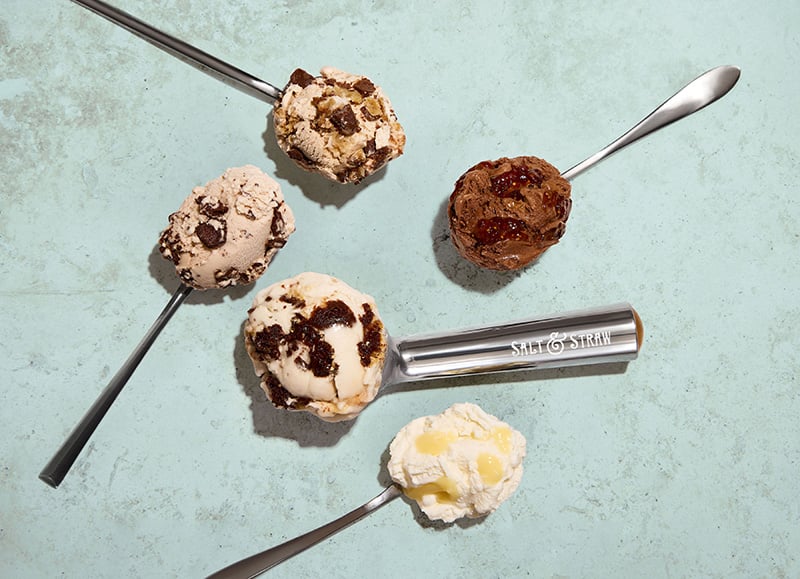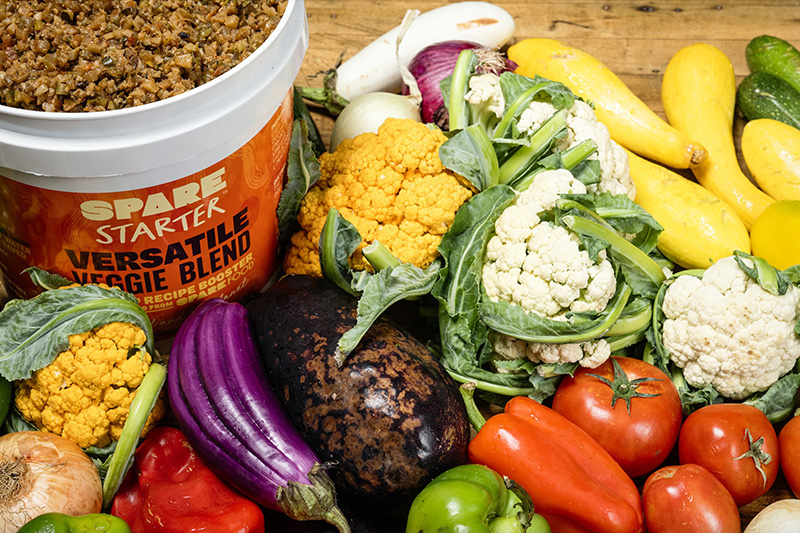6 upcycled food trends to watch
When FoodPrint published its first piece on upcycled food producers, back in 2019, startup brands were jumping into the food waste conversation, proposing a way to salvage some of the massive amounts of food — 125 to 160 billion pounds, by some estimates — lost or wasted in the U.S. each year.
Rotting food produces huge amounts of climate-warming methane; could we keep food waste out of the landfill by finding new ways to eat it? The possibilities were exciting. Still, the companies we featured, and the ingredients they built their businesses on, were fairly limited: spent grains from brewing, whey from yogurt production, leftover pulp from making juices and soy milk. As Drexel Food Lab director Jonathan Deutsch told us around that time, when it came to fighting food waste, upcycling efforts represented only a “tiny, miniscule dent.”
A lot has changed since 2019. The Upcycled Food Association (UFA) was founded later that year to bring together like-minded producers; by late 2020, its membership had increased more than tenfold. In 2021, UFA launched its own certification program, the first of its kind: Upcycled Certified, which requires a supply chain audit and measures the amount of potential food waste diverted by a given product. Now, with nearly 500 products bearing the label, the program has been acquired by Where Food Comes From, a large third-party certifier.
“Overall, the upcycled food products market is experiencing robust growth,” says Angie Crone, UFA’s CEO. In 2021, an Allied Market Research analysis valued the market at $53.7 billion; it also predicted that number would reach $97 billion within a decade. “Turning wasted food into a revenue stream while meeting the increasing consumer demand…is, frankly, a no-brainer,” Crone says, citing “resilience against supply chain disruptions” as one of the many benefits for brands.
We checked back in with Deutsch, now a member of the Specialty Food Association‘s trendspotter panel, who has also noticed a shift. “It’s definitely a growing category, but it’s also a normalizing one,” he says. “When I started in this field, the conventional wisdom was that consumers would reject products if they knew they were made from food that would otherwise be wasted.” These days, though, some data suggests that up to 41 percent of shoppers are familiar with the upcycling concept — meaning there’s less need for brands to explain “the what and why.” Instead, Deutsch says, brands can treat upcycled ingredients like “a product attribute along with others.”
Upcycling is also being taken more seriously as a policy tool. Crone notes the recent inclusion in the proposed national food waste strategy and the EPA’s updated Wasted Food Scale, indicating growing recognition of upcycling as “a high-impact, circular solution to combat the climate crisis at the federal level.”
Will upcycling ever be a comprehensive solution to our food waste woes? The answer is likely no — or rather, that we can’t do it with upcycling alone. Food waste still produces an estimated 6 to 8 percent of global greenhouse gas emissions, and bringing that figure down will require massive change on many levels. But the dent upcycling is making is only growing. And interest in upcycled products, from consumers and companies alike, doesn’t seem like it will be flagging any time soon. Deutsch puts it simply: “It’s the right thing to do, and it’s good business.”
Keep reading for some trends we’re seeing as upcycled food finds its footing.
Rescued produce gets saucy
In 2022, we invited Matriark Foods founder Anna Hammond to talk to us about the problem of food waste on the first season of our podcast. Launched with food service settings in mind, Matriark has since ventured into grocery: Its flagship tomato sauces, made with imperfect and surplus plum tomatoes, are now available in stores throughout the New York City area. Turns out, blending scraps and surplus into something new is a great way to transform them. Brooklyn’s City Saucery also makes its tomato sauces with “ugly” tomatoes. Elsewhere in the country, Maine-based company Scraps makes pesto, zhoug and chimichurri with carrot tops from local farms, and condiments company Fila Manila makes its banana ketchup — ubiquitous in Filipino cuisine — with upcycled bananas.
More brands take a “whole pod” approach
After beans are extracted from the cacao pod for chocolate production, there is little market for the fruit and husk that makes up the rest of it — meaning many cacao growers must essentially throw away the bulk of their crop. One company trying to change that is Upcycled Foods, Inc. (formerly ReGrained), which recently partnered with Xoca to source surplus cacao fruit from small family farmers in Ecuador for a unique and versatile syrup. Xoca uses the cacao syrup in its sparkling drinks; it’s also the base of other products, like the new mole bitters from Fee Brothers. Other entities working to rescue cacao fruit and pods include Koa and Candid, both of which use cacao fruit pulp in their products, and Hershey-backed Blue Stripes, from the founder of chocolate company Max Brenner — which uses cacao fruit and husk in its chocolate bars and other products. The Cocoa Future Collaborative has rounded up even more ways producers are using the rest of the cacao, from snacks to spirits.
Upcycling hits the sweet spot
It’s not just chocolate — Deutsch identifies ice creams and confections more broadly as categories to watch. Products like baking mixes can be an effective way to sneak in unusual ingredients: UFA member company Bake Me Healthy, for example, makes various vegan mixes with additions like the husks of coffee cherries and the pulp that’s left over after sunflower oil production. Portland-based based ice cream company Salt & Straw launched an upcycled foods series in 2023, incorporating ingredients like upcycled okara (soybean pulp) from Renewal Mill and bread pudding made with stale loaves from restaurants and grocery stores, part of a partnership with Urban Gleaners. The next collection of upcycled flavors is coming later this year. And surplus produce is the foundational ingredient in FAVES: a new candy product from Amy Keller, whose family founded the Spangler Candy Company (maker of Dum Dums lollipops). The idea, Keller says, came to her while reading “Drawdown,” a best-selling book of strategies for climate mitigation. “I grew up around candy,” she explains. “I wanted to push it further…into something with even more lasting impact.”

Pet food uses (even more) leftovers
You could say the pet food industry was actually upcycling long before it was cool — though companies rarely found it helpful to describe their products as a slurry of lung, liver, chicken meal and other meat and fish substances. (Especially considering that their supply chains, as a recent ASPCA campaign reminds us, often go back to the same destructive factory farms that supply human grocery stores.) But now, in the “gourmet pet food” era, the well-established approach of repurposing scraps for our pets is being reimagined, or at least rebranded. Interestingly, it’s rarely the meat itself that’s being marketed as “upcycled,” though it’s a growing area of research and development. Instead, many of the UFA’s member pet food producers are supplementing meaty treats with other upcycled ingredients, like grains, potato flour or apple pomace. Shameless Pets sources surplus eggshells, vegetables, salmon skins and even lobster (55,450 pounds saved, according to their website). There’s even a company, Pezzy Pets, making treats with invasive aquatic species. It’s not upcycling in the strictest sense, but it’s still inventive — who knows, maybe silver carp chips will be your dog’s next favorite snack.
Whey continues to reign
Back in 2019, we wrote about how White Moustache founder Homa Dashtaki created a line of probiotic drinks and popsicles after finding herself “up to her neck in whey.” You’ll get two to three pounds from making one pound of yogurt, or up to nine pounds per pound of cheese — meaning whey is an inconveniently plentiful byproduct for many dairy companies, one that can pollute waterways when improperly disposed of. (“If I could make it disappear from my farm, I would,” one cheesemaker told The Counter in 2018.) And Dashtaki isn’t the only one thinking about solutions. Superfrau, which now offers five flavors of its brightly packaged fizzy drinks, sources whey from yogurt producers in Pennsylvania. The latest project from Belcampo Meat Co. founder Anya Fernald is Shakewell, a line of upcycled-whey-based protein shakes. Whey is even making its way behind the bar: Wheyward Spirits, founded by food scientist Emily Darchuk, produces a proprietary clear spirit and a “wheyskey” with whey waste from partner cheesemakers. White Moustache is also selling its whey to others, including The Spare Food Co., makers of whey-based Spare Tonic.

Photo courtesy of The Spare Food Co.
Sometimes, you won’t realize you’re eating something upcycled at all
The Spare Food Co.’s next step: branching out into the world of vegetables. In late 2023, with the goal of rescuing and repurposing as many as possible, the company launched a ready-to-cook mix called Spare Starter — a chopped vegetable blend sourced from farms with unharvested surplus that can be folded into everything from sauces to casseroles to ground meat dishes. (Look out for the Spare Burger, made with a 70/30 mix of beef and Starter, coming soon.) The product was designed specifically for food service and institutional settings, where it can help chefs add more plants to the menu while saving time and money on prep; Harvest Table Culinary Group, a sustainability-focused division of Aramark that operates on college campuses, was an early adopter. It’s a great reminder that one of the best ways to use up veggies — especially ones that are soft, wrinkled or at risk of becoming waste — is by using them to stretch a dish you already love making.
Get the latest food news, from FoodPrint.
By subscribing to communications from FoodPrint, you are agreeing to receive emails from us. We promise not to email you too often or sell your information.
Top photo by dmitrymoi/ Adobe Stock.
More Reading
What is Europe getting right about food waste in schools?
November 15, 2024
Municipal composting has increased, but what does that really mean?
May 16, 2024
Food scholar Darra Goldstein on the culinary history of preservation
October 30, 2023
Candying is the sweetest way to prevent food waste
October 12, 2023
Colleges have high rates of food insecurity and food waste. Students are helping address both.
October 4, 2023
The FoodPrint Guide to Freezing
August 3, 2023
How to Prevent Garden Food Waste
July 11, 2023
Create Less Waste and More Color in Your Kitchen with Natural Dyes
April 27, 2023
Ways to Use a Home Dehydrator to Reduce Food Waste
August 12, 2022

